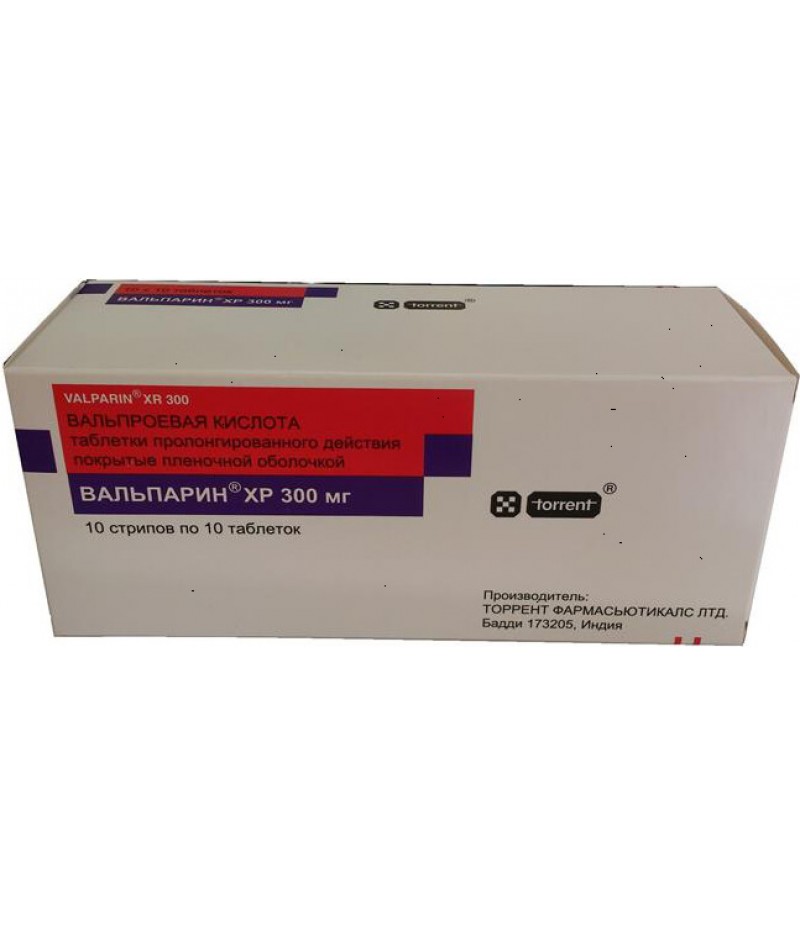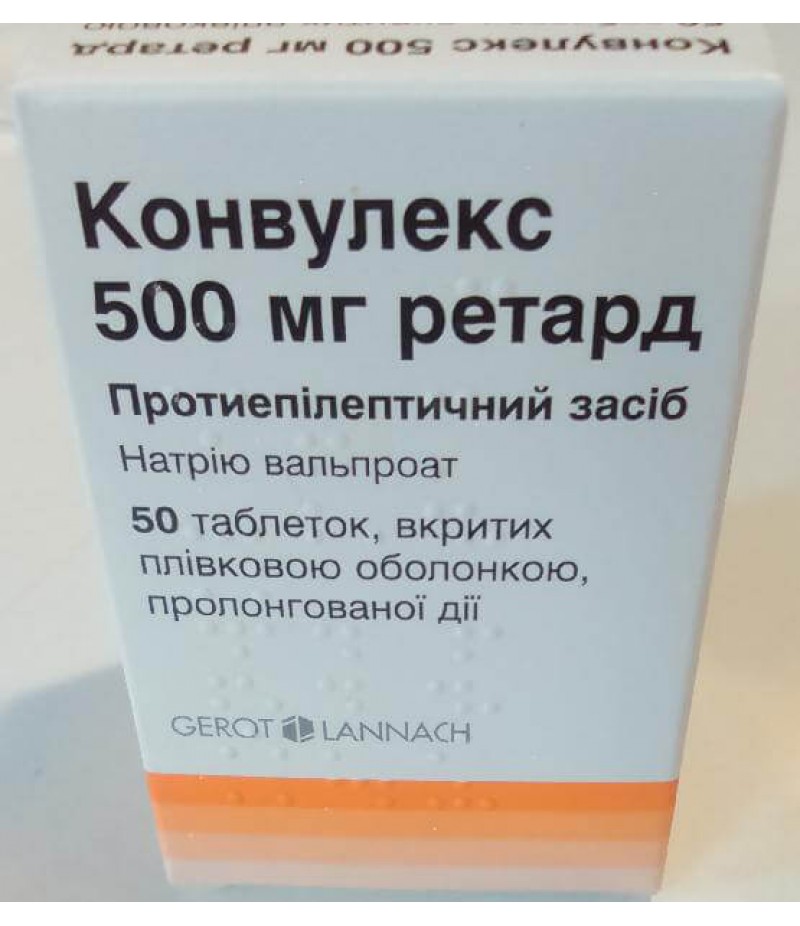Valparin XP tabs 300mg #100
- $47.27
- 2 or more $46.50
- 3 or more $45.90
- Availability:In Stock
Valparin XP user manualYou can buy Valparin XP on this pageCompositionTablets: sodium valproate, valproic acid, ethylcellulose, colloidal silica, hydroxypropylmethylcellulose, silica, sodium saccharinate, glycerol; titanium dioxid..
Tags: tabs
Valparin XP user manual
You can buy Valparin XP on this page
Composition
Tablets: sodium valproate, valproic acid, ethylcellulose, colloidal silica, hydroxypropylmethylcellulose, silica, sodium saccharinate, glycerol; titanium dioxide, eudragit, polyethylene glycol, talc.
Form of issue
Tablets with prolonged action (Valparin HR500, Valparin XP 300) in a film shell of round shape, biconvex white in a strip of aluminum foil of 10 tablets in a carton No. 30 or 100.
pharmachologic effect
Anticonvulsant.
Pharmacodynamics and pharmacokinetics
Pharmacodynamics
The drug with antiepileptic effect, has a muscle relaxant and sedative effect. The mechanism of action is the inhibition of GABA-transferase in the brain under the action of valproic acid and a decrease in the reuptake of GABA, which leads to a decrease in the excitability of the motor zones of the brain and a decrease in the appearance of the convulsive component. The therapeutic effect is to normalize the mental status of patients with different types of epilepsy and their mood, has antiepileptic activity. Does not have a therapeutically significant hypnotic and sedative effect, does not depress the function of the respiratory center, does not affect blood pressure, renal function, heart rate and body temperature.
Pharmacokinetics
The drug is rapidly absorbed into the digestive tract, bioavailability is almost 100%. Communication with blood proteins at the level of 90-95%. It penetrates through the BBB and into the cerebrospinal fluid. The half-life is 16 hours. It is excreted in the form of glucuronide mainly with urine. Does not affect the biotransformation process of estrogens, vitamin K antagonists, progestogens.
Indications for use
Treatment of epilepsy of various genesis;
Cessation of generalized and partial epileptic seizures, as well as convulsive component in organic brain diseases;
With changes in the behavior and nature of the patient, caused by epilepsy;
Syndrome Vesta, Lennox-Gastaut;
Children's teak and febrile convulsions in children;
In the complex therapy of manic-depressive psychosis, occurring with bipolar symptoms and in the ineffectiveness of prescribing other drugs.
Contraindications
High sensitivity to the drug, hepatitis, which occurs in acute or chronic form, pancreas diseases, hemorrhagic diathesis, porphyria, I trimester of pregnancy, expressed thrombocytopenia, lactation period, age up to 3 years, (for tablet form).
Take with caution in anemia, leukopenia, thrombocytopenia caused by oppression of bone marrow hematopoiesis, kidney failure, brain diseases with organic lesions, hypoproteinemia, congenital fermentopathy, mental retardation of children.
Side effects
Drowsiness, dizziness, headache, dysarthria, encephalopathy, stupor, enuresis, impaired consciousness, changes in mental state of mood or behavior, (aggression, depression, hallucinations, fatigue, psychoses, unusual arousal, irritability, motor anxiety), nausea, vomiting, appetite disorders, diarrhea, nystagmus, diplopia, anemia, leukopenia, weight gain or decrease, allergic reactions, alopecia, dysmenorrhea, peripheral edema, skin rash.
Valparin, instructions for use (Method and dosage)
Tablets Valparin XP do not chew during or after a meal, with water 2-3 times a day. Children are allowed to mix syrup with any liquid or add to their food. Use the drug in the form needed with a measuring cap.
When using the drug as monotherapy, the initial dose for adults is 5-15 mg / kg / day, then it is gradually increased by 5-10 mg / kg / week. Children weighing more than 25 kg are given a similar dose of the drug. The maximum daily dose is 30 mg / kg and, if possible, monitoring its concentration in the blood can be increased to 60 mg / kg.
When using the drug in combination therapy, the daily dosage for adult patients is 10-30 mg / kg, followed by an increase of 5-10 mg / kg weekly.
Children weighing less than 20 kg of tablets should not be used. In severe cases, the drug can be injected intravenously into a jet or IV drop by 400-800 mg at a rate of 25 mg / kg for 24, 36, 48 hours. During the reception of the drug, it is prohibited to drink drinks that contain ethanol. Also, during this period, it is recommended that the diet be observed because of the risk of weight gain.
Overdose
Symptoms of overdose are manifested by nausea, dizziness, vomiting, muscle hypotension, diarrhea, breathing disorder, hyporeflexia, miosis, metabolic acidosis, in severe cases - coma and brain edema.
Interaction
The drug enhances the effect of other drugs that have antiepileptic effects (lamotrigine, phenytoin), antidepressants, antipsychotics (neuroleptics), MAO inhibitors, timoleptics, anxiolytics, barbiturates, ethanol. When the drug is taken together with the primidon or barbiturates, the concentration of these drugs in the blood increases. Valproic acid increases the half-life of lamotrigine and slows its metabolism, reduces the clearance of zidovudine.
With the joint administration of valproic acid with ethanol or drugs depressing the central nervous system (antipsychotic drugs, tricyclic antidepressants, MAO inhibitors), there is an increase in oppression of CNS functions.
Hepatotoxic drugs, including ethanol, increase the risk of developing liver diseases. MAO inhibitors, antidepressants, antipsychotics and other antipsychotic drugs that reduce the level of convulsive activity, adversely affect the efficacy of valproic acid. When the drug is combined with salicylates, the action of valproic acid, the effect of antiaggregants and indirect anticoagulants is enhanced. Felbamate increases the concentration of valproic acid in the blood.
When combined with phenobarbital, mefloquine, phenytoin, carbamazepine, the metabolism of valproic acid is increased and its content in the blood decreases. The drug does not reduce the effectiveness of oral contraceptives.
Storage conditions
At temperatures up to 25 ° C.
Shelf life - 36 months.
Reviews about Valparin
According to the doctors' opinions, the appearance of chrono-valproate forms (Valparin Chrono) has significantly reduced the risk of side effects caused by a peak in the concentration of valproate in the blood and increased efficacy of therapy. At the same time, the tolerability of the prolonged forms is comparable with slow release preparations. Valparin XP is most effective in the treatment of generalized and convulsive tonic-clonic seizures.
The drug is also effective against secondary generalized and partial seizures. Valparin XP can be used both as a mono and as a polytherapy for epileptic seizures of various forms of epilepsy, with primary generalized seizures. Refers to the drugs of the first row of choice. To its advantages can be attributed and relatively low cost relative to the original drugs.


